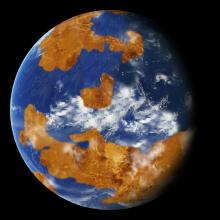Listen to today's episode of StarDate on the web the same day it airs in high-quality streaming audio without any extra ads or announcements. Choose a $8 one-month pass, or listen every day for a year for just $30.
You are here
Moon and Venus
During its first couple of billion years, Venus could have been warm and wet — a paradise for life. Research in recent years says it could have had a global ocean — a perfect place for life to take hold.
Today, though, the planet is anything but paradise. The surface temperature is about 865 degrees Fahrenheit, and the surface pressure is more than 90 times greater than Earth’s.
The change probably was caused by a runaway greenhouse effect, which began as the Sun got brighter. When it was born, the Sun was a good bit fainter than it is today. That allowed the ocean on Venus to form in the first place.
As the Sun aged, though, it got brighter and hotter. The water in Venus’s ocean began to evaporate. The extra water vapor in the atmosphere trapped more of the Sun’s heat, speeding up the process.
Radiation from the Sun zapped water molecules in the atmosphere, splitting them apart. The hydrogen escaped into space, while the oxygen combined with carbon to make carbon dioxide. At first, most of it was locked in the rocks. As Venus got hotter, though, more and more was released into the air. The CO2 trapped even more solar energy, cranking up the thermostat even more — turning Venus from paradise to purgatory.
Venus is still beautiful to look at, though. Right now, it’s the brilliant “morning star.” It’ll stand quite close to the crescent Moon at dawn tomorrow, and farther to the upper right of the Moon on Sunday.
Script by Damond Benningfield






